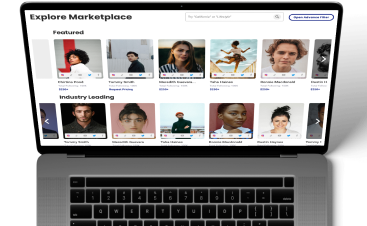In the world of influencer marketing, bigger isn’t always better. While macro-influencers with millions of followers may seem like the obvious choice for a brand looking to reach a large audience, micro-influencers are proving to be just as powerful, if not more so.
So what is a micro-influencer? A micro-influencer is an individual with a smaller but highly engaged following on social media platforms such as Instagram, TikTok, and YouTube. They typically have between 10,000 and 50,000 followers and specialize in specific niches such as beauty, fashion, fitness, or food.
So why are micro-influencers so effective? Let’s explore some of the reasons:
1. Authenticity
In today’s world of social media, influencers have become a powerful marketing tool for brands. However, with the rise of influencer marketing, there has been a shift toward micro-influencers. These influencers have a larger audience compared to nano-influencers (1,000 to 10,000 followers) but have a smaller audience compared to macro-influencers (500,000 to 1,000,000 followers), yet they are more effective in engaging their followers.
Micro-influencers are known for having a more personal connection with their followers because they share content that is genuine and relevant to their niche. This authenticity translates into higher engagement rates and increased trust from their followers.
2. Niche Audiences
One of the most significant benefits of partnering with a micro-influencer is their ability to attract highly targeted audiences interested in specific niches. A micro-influencer specializes in a particular area or interest, such as beauty, fashion, food, travel, or fitness, making them an excellent choice for brands looking to reach a particular demographic or market segment.
For example, suppose a brand wants to promote a new line of vegan protein powders. In that case, they can partner with a micro-influencer who specializes in veganism and health and wellness. These influencers have a highly engaged audience interested in plant-based diets and healthy lifestyles. By working with these influencers, the brand can reach its target audience more effectively than it would by collaborating with macro-influencers or celebrities.
3. Cost-Effective
Brands looking for influencers to promote their business through influencer marketing, but with a limited budget, may find the ideal solution in working with micro-influencers. While they may not have the same reach as macro-influencers or celebrities, they often have a highly engaged and loyal audience within their niche.
One of the biggest advantages of working with a micro-influencer is cost-effectiveness. They charge lower fees for sponsored posts and collaborations compared to larger influencers, making it easier for small businesses to work with them. Additionally, a micro-influencer tend to have a more authentic and relatable voice that resonates with their audience.
4. Better Engagement Rates
One of the key advantages of working with micro-influencers is their high engagement rates. Micro-influencers typically have higher engagement rates than macro-influencers because their followers are genuinely interested in what they have to say. They often have a niche following that shares their interests, making it easier for them to create content that resonates with their audience.
As a result, sponsored posts or collaborations with micro-influencers generate more likes, comments, shares, and overall engagement than macro-influencers who have a larger audience. Their followers are more likely to trust and engage with the content they produce because it feels authentic and relatable.
How to Leverage Niche Audiences
Now that we’ve established the power of micro-influencers let’s discuss how brands can leverage niche audiences through influencer marketing:
1. Identify Your Target Audience
Before you start working with influencers, it’s crucial to identify your target audience and understand their interests and behaviors. This will help you find the right influencers who can effectively reach your desired demographic.
To identify your target audience, start by looking at your existing customer base. Who are they? What are their interests and behaviors? What problems do they have that your product or service can solve? Conducting market research or surveys can also help you gain a better understanding of your target audience.
When evaluating potential influencers, consider factors like their engagement rates, follower demographics, content quality, and authenticity. Make sure the influencer’s voice and tone match with your brand values and messaging. You may also want to review their past collaborations to see if they align with your goals and objectives.
2. Research Influencer Niches
Once you know your target audience, it’s time to research different influencer niches that align with your brand values and goals. This will help you find influencers who can effectively reach your desired demographic and drive meaningful results for your business.
To start, look for influencers who have a strong following within their niche. This could be anything from beauty and fashion to fitness and wellness or even food and travel. Consider the type of content they create and whether it resonates with your target audience. Do they share similar values, interests, or demographics?
Next, evaluate the influencer’s engagement rates within their niche. High engagement rates suggest that their followers are highly engaged with the content they produce, which can lead to more meaningful results for your business. You can use social media analytics tools to evaluate an influencer’s engagement rates across different platforms.
3. Build Relationships with Influencers
Building relationships with influencers takes time but is crucial for successful partnerships. Engaging with them on social media by liking and commenting on their posts regularly can help establish a rapport before reaching out about potential collaborations.
When engaging with influencers, it’s important to be authentic and genuine. Don’t just leave generic comments like “Great post!” or “Love this!” Instead, take the time to read their content and leave thoughtful comments that show you genuinely appreciate their work.
You can also share their content on your own social media channels, tag them in your posts, or even collaborate with them on a smaller project before pitching a larger partnership. This will help demonstrate your interest in working with them while also giving you an opportunity to see how well you work together.
Remember that building relationships takes time and effort. Don’t expect instant results or immediate responses from influencers. Be patient and persistent in your efforts, and always respect their boundaries and preferences.
By taking the time to engage with influencers on social media before reaching out about potential collaborations, you’ll be able to establish a rapport and build trust that can lead to more successful partnerships in the future.
4. Set Clear Goals and Expectations
When working with micro-influencers (or any influencer), it’s essential to set clear goals and expectations for the partnership upfront. This will help ensure that both parties are on the same page and can work together effectively towards a common goal.
Start by defining your goals for the partnership. What do you hope to achieve through this collaboration? Do you want to increase brand awareness, drive sales, or generate user-generated content? Once you have a clear understanding of your objectives, you can communicate them to the influencer and work together to develop a strategy that aligns with your goals.
Next, be transparent about what you expect from the influencer regarding content creation, posting schedules, compensation, etc. This includes details such as the number of posts required, specific messaging or hashtags to include in each post, and any other guidelines or requirements that need to be followed.
It’s also important to discuss compensation upfront. Be clear about what you’re offering in terms of payment or other incentives and how it will be structured (e.g., flat fee vs. commission-based). If there are any other perks or benefits associated with the collaboration (such as free products or services), make sure these are clearly communicated as well.
Wrapping It All Up
In conclusion, leveraging niche audiences through micro-influencer marketing can be incredibly effective for brands looking to reach specific demographics or market segments authentically. By identifying your target audience, researching influencer niches carefully building relationships with influencers setting clear goals & expectations upfront – you can create successful partnerships that drive real results for your business. If you are looking to find a vetted micro-influencer for your brand, join Glewee today! We offer unparalleled access to influencers of all sizes and niches.





